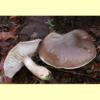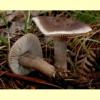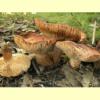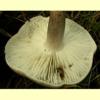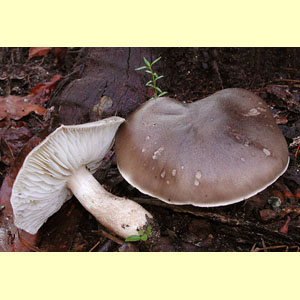
images/Tricholoma/Tricholoma_KRT2788.jpg
Medium to large agaric, growing on the ground, with a white spore print. Pileus pale, brown, red or pink, purple or grey, viscid or not. Lamellae free, adnexed, sinuate or notched, rarely adnate. Stipe central. Partial veil remnants a ring zone, a membranous annulus or absent. Spores hyaline, non-amyloid, smooth; germ pore absent. Cheilocystidia present or absent. Lamellar trama regular. Pileipellis a cutis, rarely a trichoderm. Clamp connections absent, rarely present.
Some species of
Porpoloma are very similar to
Tricholoma in the field, but the former are differentiated by the amyloid spores and the absence of an annulus, as are
Leucopaxillus and
Melanoleuca (which can both have large fruit-bodies, although the former usually with subdecurrent to decurrent lamellae).
Macrocybe has clamp connections and lacks an annulus, and is only known from Queensland. Species of
Russula often share the robust habit, but the stipe flesh is chalky (readily crumbling) and the spores have amyloid ornamentation. Larger species of
Lyophyllum lack an annulus and often stain blackish or grow in connate clusters.
Tricholoma (Fr.) Staude, Schwämme Mitteldeutschl. xxviii, 125 (1857).
Several species, with as many as ten additional undescribed species. In native forests: Tricholoma aff. acerbum, T. austrocolossum (= T. australe), T. eucalypticum and T. aff. terreum. Under exotic trees (pines): Tricholoma saponaceum (clamp connections present), T. terreum and T. virgatum.
W.A., S.A., Qld, N.S.W., Vic. and Tas. (and probably also N.T.).
In native forests and also in pine plantations.
On the ground.
Ectomycorrhizal.
Bougher, N.L. & Syme, K. (1998),
Fungi of Southern Australia. University of Western Australia Press, Nedlands. [
Description,
Illustration and
Microcharacters of
T. eucalypticum]
Breitenbach, J. & Kränzlin, F. (eds) (1991), Fungi of Switzerland. Volume 3. Boletes and Agarics 1st part. Edition Mykologia, Lucerne. [Illustration, Description and Microcharacters of T. acerbum and T. terreum from Europe]
Fuhrer, B. (2005), A Field Guide to Australian Fungi. Bloomings Books, Hawthorn. [Description and Illustration of T. austrocolossum, T. eucalypticum and T. virgatum]
Grgurinovic, C.A. (1997a), Larger Fungi of South Australia. The Botanic Gardens of Adelaide and State Herbarium and The Flora and Fauna of South Australia Handbooks Committee, Adelaide. [Description and Microcharacters of T. austrocolossum (as T. australe) and T. eucalypticum, along with Illustration of the first species]
Griffiths, K. (1985), A Field Guide to the Larger Fungi of the Darling Scarp and South West of Western Australia. Published by the author. [Illustration of T. eucalypticum]
McCann, I.R. (2003), Australian Fungi Illustrated. Macdown Productions, Vermont. [Illustration of an unnamed Tricholoma species]
Young, T. (2000a), Common Australian Fungi, [3rd] revised edn. University of New South Wales Press, Sydney. [Description, B&W Illustration and Microcharacters of T. aff. acerbum]
Young, A.M. (2005b), A Field Guide to the Fungi of Australia. University of New South Wales Press, Sydney. [Description and Illustration of T. eucalypticum]

